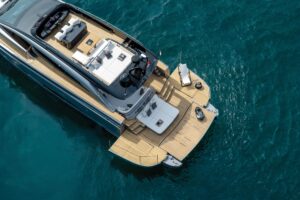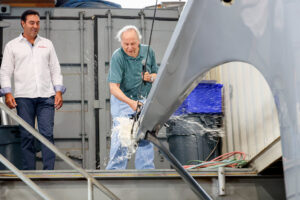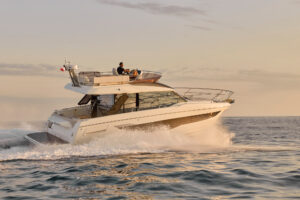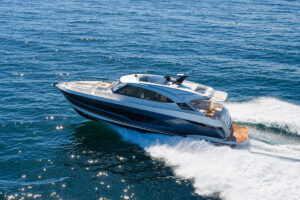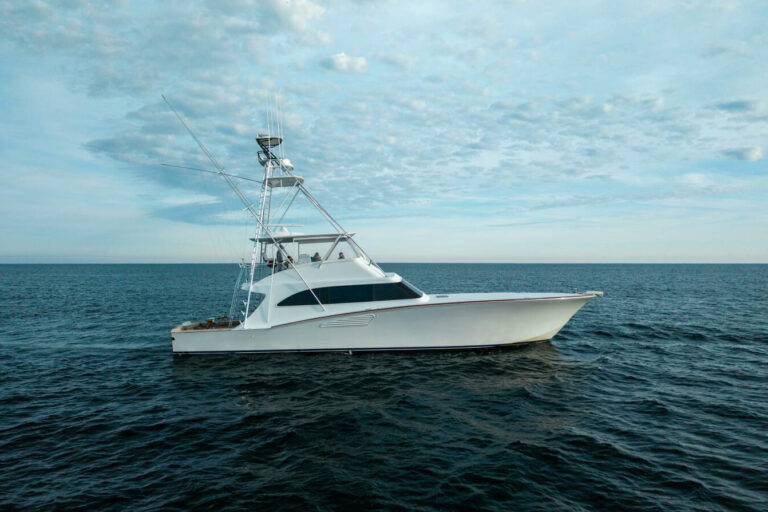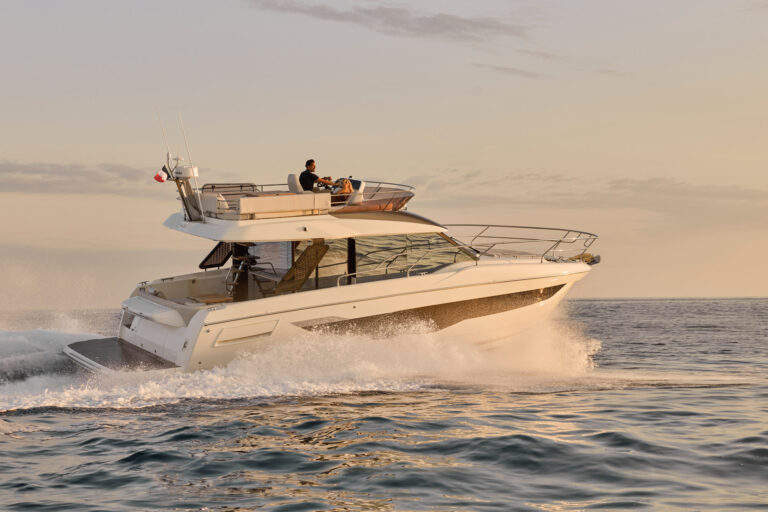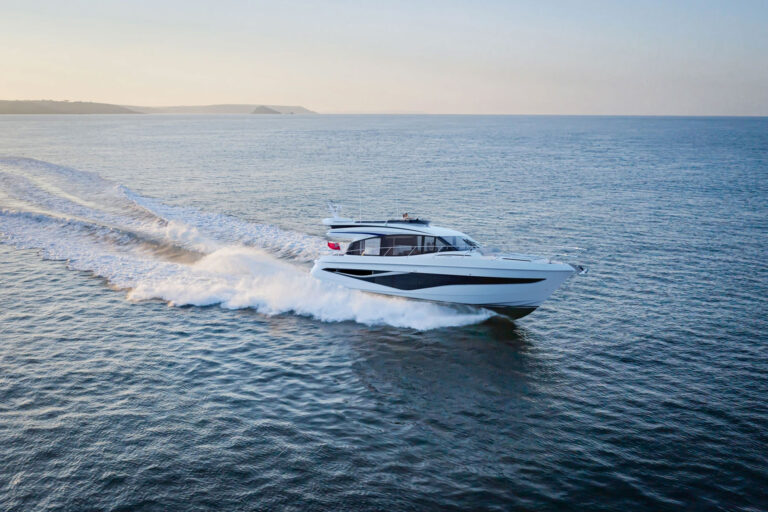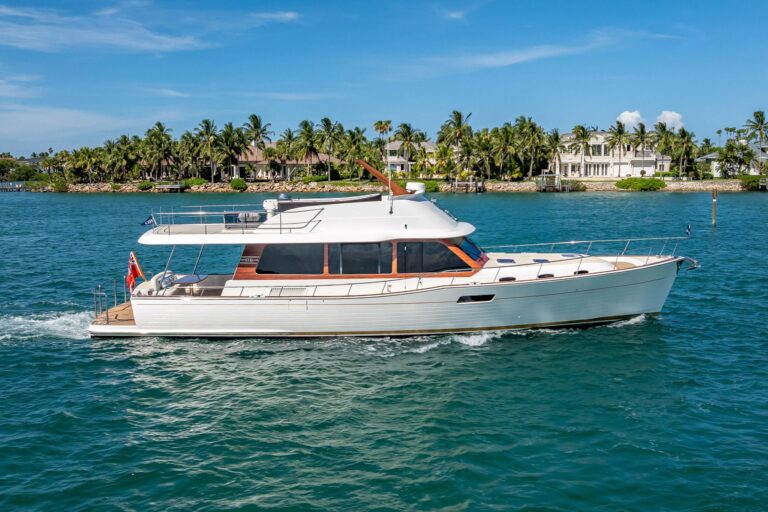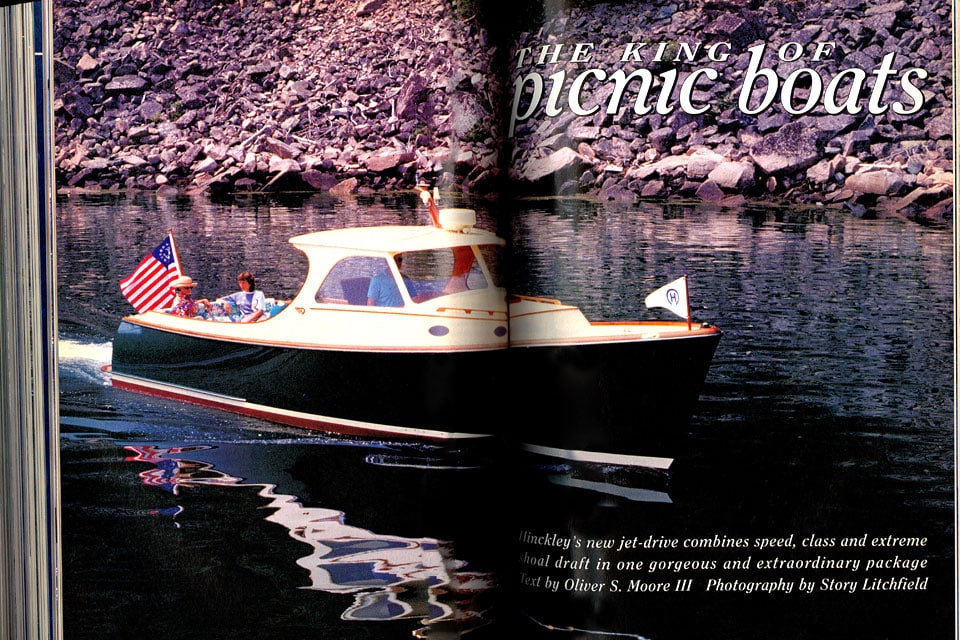
Hinckley Picnic Boat Article 1994
Shep McKenney and I share a common passion for big adventures in little boats. As I look back on my half-century afloat, the memories I seem to return to the most involve poking into the nooks and crannies of a coastline in a shoal-draft boat. Given the crowded state of today’s anchorages, gunkholing in a shoal-draft boat is about the only sure-fire way to find privacy. Shoal-draft boats are also ideal for “cocktail cruising,” which is what I call the enjoyable practice of ghosting along close to shore enjoying the sights and relaxing at the end of the day with a few friends aboard.
Trouble is that as we get older most of us start to put creature comforts first, and that inevitably leads up the long ladder of “perfect boats,” ever bigger, more elaborate and more expensive.
But Shep has an advantage over most of us who just dream about dreamboats. As head of the Hinckley Company he can turn his dreams into reality. And that is just what he has done with the new 36′ Hinckley Picnic Boat, a salty, easily driven, high-tech overnighter that is a head turner at any dock. So perfectly Down East is this Kevlar composite boat that one old salt at the recent WoodenBoat Show in Maine was overheard pontificating to friends: “Now look here, see how that deck takes the paint just so; you can never get that patina with fiberglass.”
That deck happens to incorporate a state-of-the art hybrid blend of Kevlar E-glass over a 3/4″ core of cross-linked closed-cell foam. The hull itself is also made of vacuum bagged Kevlar-E-glass with a 1″ closed-cell foam core. By utilizing a brand-new “scrimp” technology whereby resin is forced into the laminate at 2,000 psi, Hinckley’s builders were able “to produce a hull of incomparable strength at extreme low weight of just 2,300 pounds.”
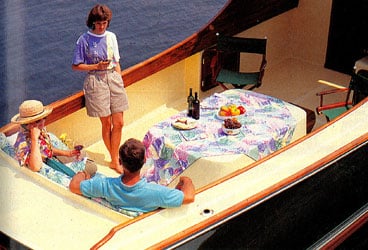
| |OUT TO LUNCH The long open cockpit is made to order for convivial entertaining with the engine box doubling as a spacious picnic table.|
Who cares about weight in a powerboat, I can hear the skeptics proclaim. “Everybody,” is Shep’s answer and I agree wholeheartedly. Weight takes power to move and that means heavier propulsion machinery, which mean smote weight and more horsepower.
By weighing everything that went into the boat, the all-up displacement is just 10,300 lb. Leaving nothing to chance, Shep had two different Bruce King underbody designs tank-tested at the Webb Institute. Bottom line is that the sleek speedster can hit a top speed of 29 knots and can easily cruise at 25 knots. Fuel consumption with the single Yanmar six-cylinder engine is an incredibly 1.9 mpg. To put that into perspective, a Brendan 32 requires twin Volvo diesels putting out 600 hp to reach 29.5 knots while burning 27.5 gph, or a slightly more than double what the Hinckley needs.
Continuing the marriage of cutting-edge technology with traditional aesthetics and incomparable finish, Shep offers the boat with a Hamilton jet drive. Jet drives have been around for a long time in smaller performance boats.

| |State of the art can only describe the helm-station electronics while Rolls Royce would envy the console.|
I still remember a run many years ago up through the sloughs of California’s Sacramento River delta in a metal-flake jet-drive hot rod. On luxury yachts, KaMeWa jet drives are considered the hottest propulsion units. But on mid-range boats, jets have never been widely used. I am going to go out on a limb and say that I predict this Hinckley powerboat will change a lot of thinking among traditional yachtsmen.
For starters, the jet drive eliminates all underwater propulsion gear. No props, struts or rudders to foul pot lines or wipe out in a grounding. Gone, too, is the loud noise of the propeller that can account for up to half of the cockpit noise in traditionally powered boats. And of course jets are safe since there are no props.
With the jet-drive option the boat draws only 18 inches, opening up vast new areas to explore—and you can safely beach the boat and go ashore to picnic or explore without worrying about grounding.

| |MANEUVERABILITY Throw the wheel over hard and hang on for a thrill as the boat executes a hook turn spinning on a dime.|
But forget all those sober advantages. What I really learned about jet drives in a day of cruising around Mt. Desert Island is that jet drives are fun to run. Like really fun. Like the kind of fun that stretches your mouth from ear to ear in a big, you-know-what eating grin as you throw the boat into a hard turn and she literally executes a moonshiner turn in her own length. Talk about pulling g-loads.
Slow-speed maneuvering is a cinch and the boat can actually pivot on her own axis. Spot an obstruction ahead? No sweat. Simply put the boat into reverse for a breathtaking stop. Remember we aren’t reversing gears. With a jet you are reversing the direction of the water flow, much as a jetliner reverses thrust on landing.
By coupling a very fine entry with 15 degrees of constant dead rise, the ride is knife-through-butter smooth. The boat is very dry with the separation point behind the wheelhouse. Moreover, because the boat is so light with so little draft and a low center of gravity, beam seas have a minimal effect; the boat seems to rise and fall without rolling from side to side as you might expect.
Under way, the turbo diesel imparts little apparent noise to the general sounds of a boat moving through water. The engine box, which can double as a seat or picnic table, is lined with lead-decoupled foam and overall sound engineering was handled by none other than the renowned Joe Smullen.

| |HOME COOKIN’ From soup to nuts is a real possibility in the surprisingly spacious galley with a two-burner LP stove and reefer.|
Below decks, the Picnic Boat exhibits her Hinckley pedigree with a teak-and-holly sole and beautifully varnished mahogany. A compact galley to port handles the cooking chores while a spacious V-berth for ward would be comfortable for a weekend cruise. To starboard is a very large head with ample counter space and a shower.
In a world of “monkey see, monkey do,” high-volume production boats, it is refreshing to experience something as revolutionary and practical as this new Hinckley. Beauty is as beauty does and this boat really does it.

Contact: Hinckley Yachts, 401-683-7005; hinckleyyachts.com
View photos of the Hinckley T48FB here.

